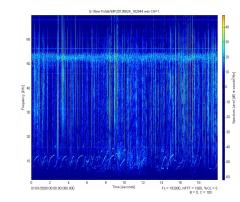NOAA Teacher at Sea
Adam Renick
Aboard NOAA Ship Oscar Elton Sette
June 12–26, 2013
Mission: Kona Integrated Ecosystems Assessment http://www.pifsc.noaa.gov/kona_iea/
Geographical area of cruise: The West Coast of the Island of Hawaii
Date: Tuesday, June 25, 2013
Weather Data
Current Air Temperature: 77° F
Sea Surface Temperature: 77° F
Wind Speed: 3 knots
Finding the Cetaceans…
In the final days of our research cruise we set out to get an assessment of cetacean activity in the Kona area that we have been studying. In addition to the ongoing active acoustics, CTD and DIDSON sampling, we have added two new tasks to the science team to find as many cetaceans as possible. We have set up a hydrophone, which is a sound recorder that sits in the water and is pulled by the ship, to listen for the clicks, whistles and any other sounds dolphins and whales might make.
For examples of sounds cetaceans make please check out this website. When the sounds from the cetaceans are received the wave frequencies are recorded using some very interesting software that helps us determine the type of marine mammal it is and where it is located. Specifically locating and identifying the cetaceans requires the cooperation of many people and is not necessarily as simple as I am making it sound here.


While the acoustics team and the ship’s crew are listening and seeking out the animals we also assist in the effort by making visual observations from the highest deck of the boat called the “flying bridge”. Here one or two people who are in communication with the science team below use binoculars and “big eyes” to visually find and identify marine mammals.

Some of my personal observing highlights of this operation include a sperm whale, a pod of approximately 150 melon-headed whales and smaller pods of spinner dolphins, rough-toothed dolphins, rough-toothed dolphin and pilot whales.

Photo: Chad Yoshinaga

Photo: Ali Bayless
Wrapping Up the Journey…
I cannot express enough gratitude to the members of the science team and the crew of the Sette for making my NOAA Teacher At Sea experience so rewarding. There are so many elements of this trip that are worth pause, reflection and appreciation. My emotions ranged from excitement just being at sea for 15 days and living a lifestyle that is unique and different than my own, the contemplative awe of the vast and complicated ocean ecosystem and the exhilaration when one of its own breaches the surface to give us a peek at it. In the end, I think my greatest appreciation gained along this journey was learning to slow myself down to the pace of nature in order to better observe and understand it.What’s next for me? NASA Teacher In Space… 2014 here I come!
Just kidding (is that even possible?) Until then I guess I should practice my moon-walking on Kilauea crater until I head back to my amazing wife and life in San Diego. Thanks for reading and, whatever you are doing out there in the world today, make a memory.











 After about an hour of doing this the net is pulled back up to the ship where all the creatures are collected in a bag called a “cod end”. It may sound fairly simple, but this process requires the coordination of many different people as the scientists need to communicate with the deck operations crew, and the deck crew has to work with the captain to ensure that the very long net line hits the target and does not get tangled or damaged in the process. Keep in mind that this is happening at 1:00am with 20 knot winds and 10 foot waves. It is a wonder to see and be a part of this operation.
After about an hour of doing this the net is pulled back up to the ship where all the creatures are collected in a bag called a “cod end”. It may sound fairly simple, but this process requires the coordination of many different people as the scientists need to communicate with the deck operations crew, and the deck crew has to work with the captain to ensure that the very long net line hits the target and does not get tangled or damaged in the process. Keep in mind that this is happening at 1:00am with 20 knot winds and 10 foot waves. It is a wonder to see and be a part of this operation.












